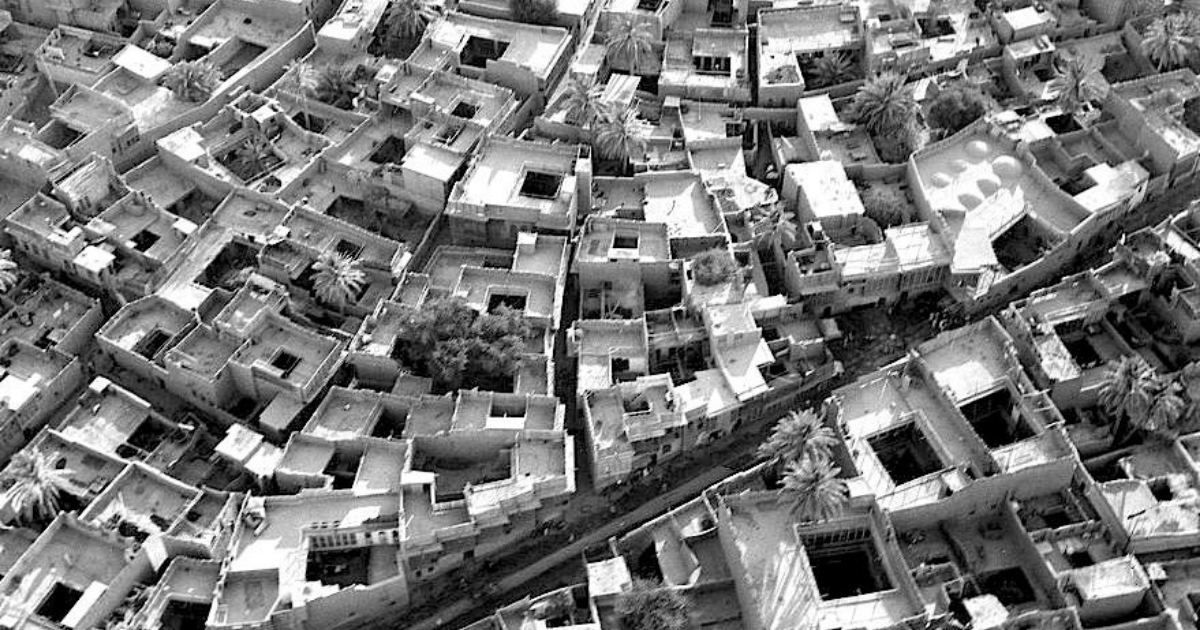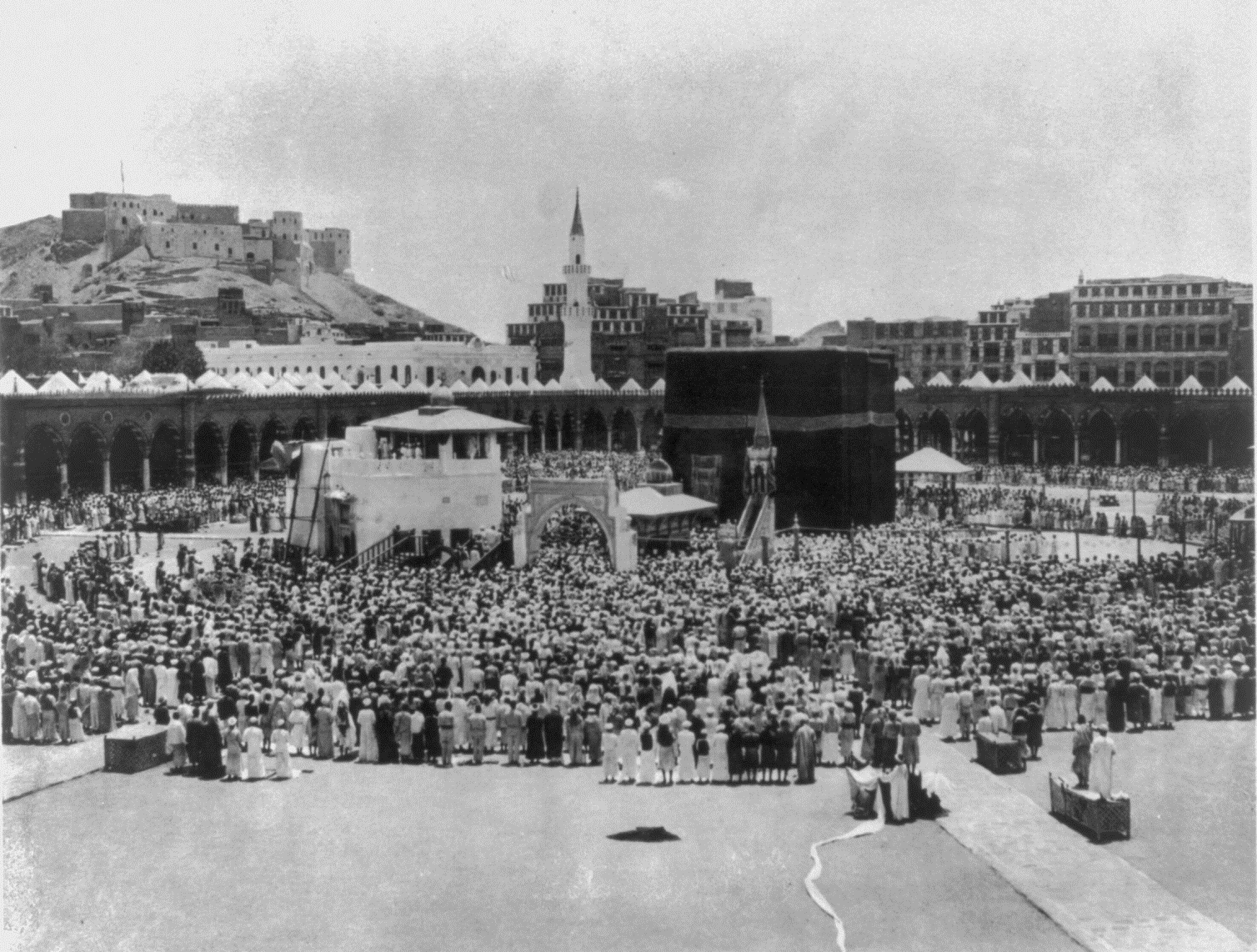Bottom-Up Approaches in Governance & Dynamic Building Regulations in the Arab-Islamic Urban
Aerial photograph of Baghdad Iraq. Taken between 1920-1934. (Granger Historical Picture Archive)
The concept of Islamic urbanism and architecture has been extensively talked about in academia and print media. It continues to be a point of fascination to many: the geometric spaces and patterns, the meticulous ornamentations which decorate the buildings, the grand mosques, and luxurious castles, but what is often neglected are the principles of which Islamic urbanism is built upon: sharia, and the traditional bottom-up approach to urban governance in the Arab-Islamic urban context. Researchers on the old traditional cities of the Middle East and North Africa note that they are organic and unplanned, while this is certainly true, the framework of urban governance in Islam was very conventionally different from the planning oriented approach in the West, which came to dominate the field of city planning and urban design. When talking about traditional urban spaces across the Islamic world, the same orientalist tropes are often regurgitated without much critical thinking: they are chaotic and hectic because of their organic and unplanned nature, however, when looking at context clues in the Islamic urban and we begin to understand that the opposite is very much true.
Oleg Grabar opens his article on the Growth and Culture of Urban Islam with an inscription on a mosque from the eleventh century:
“This mosque was built by al-Husayn ibn ‘Abdallah ibn Muhammad ibn Silsila, the cloth merchant, in his desire to seek the satisfaction of God and of the other world. May God have mercy upon whomever recites a [pious] formula for him, during his lifetime or after his death. The palm tree which is in this mosque is food for Muslims; it can neither be bought or sold.”
This inscription clearly states the rules and regulations behind the fruit-bearing tree within the mosque’s space. Islamic urbanism and Islam of this era is illustrated as a world of mystic scholars contemplating profound realities, but the truth is that the scholars of this age were able to intersect the physical and spiritual needs in a practical and realistic manner, that is rooted in the fear of God.
Architecture as a medium is molded by the environment. The climate shapes what is needed structurally, and the ecology provides the materials on which those structures are built upon. These materials shape the aesthetic of the buildings and the culture further refines these aesthetics. Urbanism also reflects the spiritual necessities of society. As adherents to sharia, abiding by a set of rules and laws prescribed from the Quran and hadith, the built environment had to facilitate these spiritual needs. As a result, the Arab-Islamic urban is characterized by a large central Friday mosque (jami’), and its winding and bustling marketplaces, (souq or bazaar). Open spaces were limited, reserved for private residences, multi-family homes often had a central courtyard for open space. Depending on the climatic conditions of the sub-region, they would vary in size to give more shading or allow for greater ventilation. The orientation of the streets provides a greater sense of privacy for women, with certain access points to houses only accessible to families of a certain neighborhood. This shows that a great deal of thought and care went into procuring urban spaces in the Islamic world. It lacks any sense of chaos that ‘organic’ growth would bring.
Privacy is the most prominent element of Arab-Islamic urbanism and architecture. Privacy in the Islamic context “enhances autonomy and... minimizes vulnerability”. This physical space reflected this spiritual need, and because the shape of the urban fabric was involved. The primary concern of this concept was to protect the family’s visual privacy. The Islamic concept of mahram, which defines the relationship between men and women by blood ties or marriage affected where and how families socialize and interact with ‘strangers’ to the family. As a result, the jurists of the Islamic urban environment dictated certain rules that would protect the privacy of households. This included the fact that families and strangers had separate entrances, which would lead to a majlis to welcome guests or directly to the home; where windows can and can’t be built; and building heights. The building of new houses and streets were highly regulated by the community collectively. The heads of the households, the sheikh, qadi, muhtasib, and imam were all highly involved in the mediation and regulation of privacy.
While there was no ‘zoning code’ to speak of, buildings in the traditional Islamic city were highly regulated. The location of shops, the width of streets, the heights of buildings, the position of doors and windows, were all of great importance. These rules were agreed upon based on commonsense and in agreement with sharia. Regulations also changed, shifted, and evolved as the needs of the community changed and the urban fabric grew. This was an advantage that Islamic urbanism enjoyed over traditional zoning regulations, which remain static. Regulations changed on a case-by-case basis. The rules were very much malleable and based on community consensus. Governance in Islamic urbanism emphasized a bottom-up approach, which built strong ties across the community and fostered engagement amongst all participants of the city through a shared understanding of the common good.
Hierarchy of the interpretation of Islamic jurisprudence.
This bottom-up approach was built upon the organizational hierarchy of how sharia is interpreted. Islamic sharia is comprised of the Quran, sunna (the set of traditions and practices of the Prophet that constitute a model for Muslims to follow), qiyas (deduction of religious texts by analogical reasoning), and ijma (consensus amongst scholars). The interpretation of sharia begins at the top of the hierarchy with the ulama, religious scholars who are schooled in Islamic doctrine and jurisprudence (referred to as fiqh in the Islamic community). Next in the hierarchy are the local judges, known as the qadi. The qadi acted as a community mediator in all issues, including those related to building regulations in accordance with one of the major schools of fiqh, known as madhab. The qadi would sometimes be accompanied by a mufti in mediation efforts, who acted as a juror. The former has the authoritative power to apply and enforce the established rules while the latter provides information on the juridical-moral status of an act is. Finally, the muhtasib would act as a district supervisor to promote good and forbid evil and maintain that public business was conducted in accordance with Islamic jurisprudence. The muhtasib oversaw the supervision of markets, suqs, and bazaars.
While the Islamic city certainly lacked the European model of zoning, its building regulations were incredibly dynamic and facilitated an evolving set of rules and guidelines that could be adjusted in accordance with the need of the community and the urban form. The community and its stakeholders adjusted regulations on a case-by-case basis regularly. Today’s zoning code in cities across the world limits the ability that communities and decision-makers have in changing regulations in accordance with the needs of the community. Scaling back to the geographic focus of this blog, relating to the Khaleej and the Arabian Peninsula, where our zoning code and urban design mimic that of the West, is there any place for traditional bottom-up approaches to urban governance in the modern urban fabric? Is it possible for our building regulations to become dynamic, where rules can be reevaluated on a case-by-case basis in today’s urban landscapes? I await your comments and engagements!











